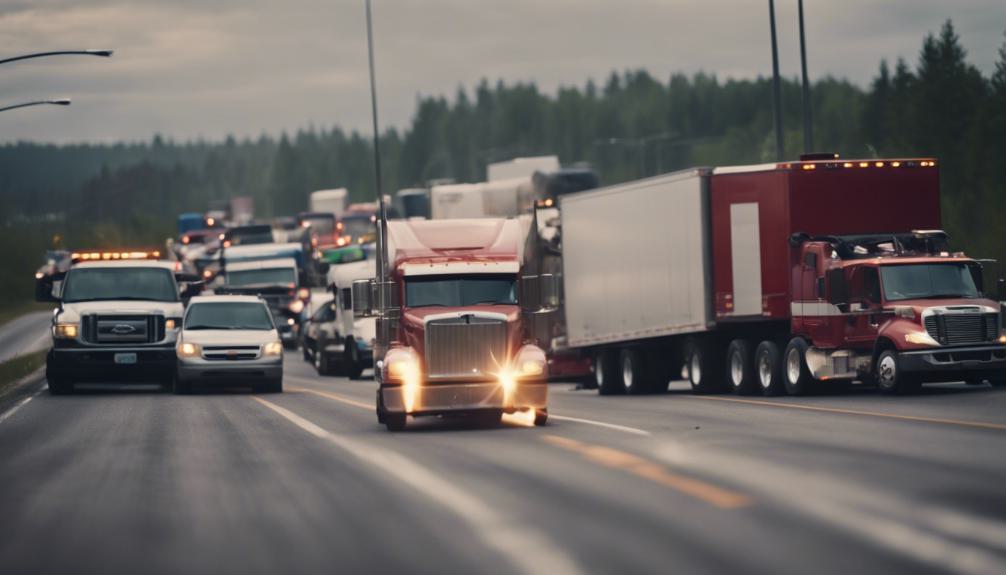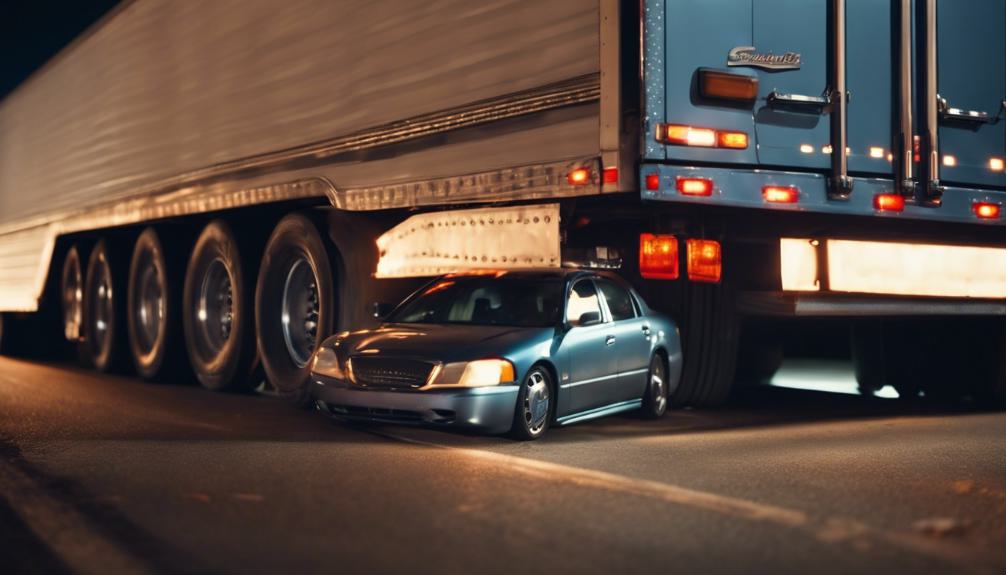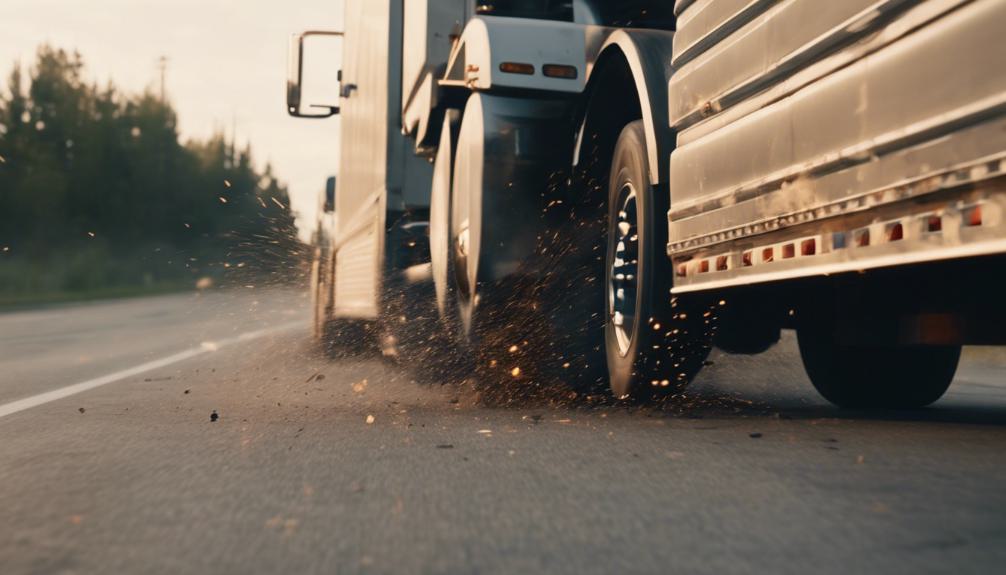What Are the Most Common Types of Commercial Truck Accidents?
In the domain of road safety, commercial truck accidents stand out not only for their potential severity but also for the intricate factors contributing to their occurrence. Among these incidents, certain types are more prevalent, including rear-end collisions, head-on impacts, underride situations, rollovers, and tire blowouts, each presenting distinct challenges and implications for all involved. Understanding the nuances of these accident types is important for developing effective prevention strategies. As we explore the underlying causes and preventive measures associated with each category, one is compelled to ponder how this knowledge could transform our approach to enhancing road safety and minimizing the risks associated with commercial trucking operations.

Key Takeaways
- Rear-end collisions often occur due to semi-trucks' longer braking times and can be mitigated by maintaining a safe distance.
- Head-on collisions, usually resulting from driver distraction or fatigue, underscore the need for alertness and defensive driving.
- Underride collisions, where smaller vehicles slide under semi-trailers, are among the deadliest and stress the importance of visible underride guards.
- Rollover accidents and tire blowouts highlight the significance of cautious driving in adverse conditions and regular vehicle maintenance.
Rear-End Collisions

Rear-end collisions, characterized by their sudden and forceful nature, prominently highlight the necessity for increased stopping distances when semi-trucks are involved. These accidents often occur due to the considerable time it takes for a fully loaded semi-truck to come to a complete stop, notably more than that of a passenger vehicle. Factors such as poor weather conditions, including snow, rain, or hail, exacerbate these risks by reducing visibility and further increasing braking distances. Motorists are advised to maintain a safe distance from semi-trucks, especially in adverse weather conditions, to prevent rear-end collisions. Adhering to this precaution not only enhances safety on the roads but also minimizes the likelihood of engaging in these potentially devastating accidents.
Head-On Collisions

While discussing the dangers associated with semi-trucks, it is essential to address head-on collisions, which often result from driver distraction or fatigue. These types of accidents are particularly catastrophic due to the substantial size and weight difference between semi-trucks and passenger vehicles. The consequences can be severe, leading to significant injuries or fatalities. It's vital for drivers to remain alert and focused, especially at intersections where errors can lead to head-on collisions. Vigilance and awareness of oncoming traffic can mitigate some of these risks. Motorists should also understand the importance of maintaining a safe distance from semi-trucks, giving themselves ample time to react to sudden movements or changes in traffic flow. Avoiding distractions, adhering to speed limits, and practicing defensive driving are key measures to prevent head-on collisions with commercial trucks.
Underride Collisions

Underride collisions, a terrifying consequence of smaller vehicles sliding underneath semi-trailers, often occur due to abrupt stops or lack of spatial awareness. These accidents are among the most deadly, as the top of the passenger vehicle can be sheared off, leading to severe injuries or fatalities. The dynamics of underride collisions involve important discrepancies in vehicle size and height, making it critical for semi-truck drivers to guarantee their tail lights and underride guards are properly maintained and visible. For motorists, maintaining a safe distance from semi-trucks, especially in poor visibility or heavy traffic conditions, is essential. Awareness and defensive driving techniques can notably reduce the risk of these catastrophic accidents, emphasizing the importance of vigilance on the road.
Rollover Accidents

Shifting focus to another significant hazard on the roads, rollover accidents represent a serious risk for semi-trucks due to their high center of gravity. These incidents occur when a truck loses its balance and tips over, often as a result of driving through windy conditions or steering too sharply. The design of these vehicles makes them particularly vulnerable to tipping under certain conditions. To mitigate this risk, it is essential for truck drivers to exercise extreme caution when making turns, especially at high speeds, and to be mindful of the weather conditions that could exacerbate the likelihood of a rollover. Additionally, other motorists should give trucks ample space, particularly in areas prone to strong winds or on tight turns, to reduce the chance of being involved in a rollover accident.
Tire Blowouts

Tire blowouts are a prevalent issue among semi-trucks, often leading to hazardous road conditions and accidents. These incidents primarily occur due to the significant wear-and-tear these vehicles endure, compounded by the heavy loads they carry. When a tire blowout occurs, it can cause the driver to lose control, leading to collisions with other vehicles or obstacles. Additionally, the debris from the blown tire poses a risk to following vehicles, potentially causing secondary accidents as drivers swerve to avoid the remnants. Motorists are advised to maintain a safe distance from semi-trucks and remain vigilant for signs of tire distress. It's also critical for truck drivers and companies to adhere to maintenance schedules, inspecting tires regularly to mitigate the risk of blowouts.
Frequently Asked Questions
What Role Does Improper Loading Play in Commercial Truck Accidents?** - This Question Explores How Improperly Secured or Unevenly Distributed Cargo Can Lead to Accidents, a Topic Not Covered Under the Specific Types of Collisions Mentioned.
Improper loading plays a critical role in commercial truck accidents by affecting vehicle stability and maneuverability. Uneven or unsecured cargo can lead to rollovers and loss of control, greatly increasing the risk of accidents.
How Does Inadequate Truck Maintenance Contribute to Accident Risks?** - This Question Delves Into the Importance of Regular Maintenance in Preventing Accidents, Seeking Information Beyond Tire Blowouts to Include Brakes, Lights, and Other Critical Systems.
Inadequate truck maintenance increases accident risks by compromising vehicle integrity. Failure to regularly inspect and repair critical components, such as brakes, lights, and tires, can lead to catastrophic failures and subsequent collisions on the road.
What Impact Do Regulatory Violations Have on the Frequency of Truck Accidents?** - This Question Investigates How Non-Compliance With Hours-Of-Service Regulations, Weight Limits, and Other Legal Requirements Might Lead to Accidents, a Subject Not Addressed in the Detailed Accident Types.
In an era where regulations are more suggestions than rules, it's no surprise that non-compliance with trucking regulations greatly increases accident rates, underscoring a dire need for stringent adherence to safety standards in the industry.
How Do Training and Experience of Truck Drivers Influence Accident Rates?** - This Question Aims to Understand the Correlation Between a Driver's Skill Level, Their Training, and the Likelihood of Being Involved in an Accident, Offering Insight Beyond the Causes Related to Physical and Environmental Conditions.
The inquiry focuses on the influence of truck drivers' training and experience on accident rates, examining how these factors correlate with the likelihood of incidents, thereby shedding light on preventive measures through enhanced educational practices.
What Are the Challenges of Navigating Insurance Claims and Litigation Following a Commercial Truck Accident?** - This Question Seeks to Uncover the Complexities Involved in Dealing With the Aftermath of Truck Accidents, Including Insurance Issues and Legal Disputes, Areas Not Discussed in the
Handling insurance claims and litigation after a commercial truck accident presents significant challenges, including intricate liability issues, extensive documentation requirements, and potential disputes over fault and damages, requiring expert legal assistance for effective resolution.
Conclusion
To sum up, commercial truck accidents pose a grave risk on the roads, with rear-end collisions, head-on impacts, underride incidents, rollovers, and tire blowouts being among the most prevalent. Each category underscores the crucial need for stringent safety measures and responsible driving practices. Is it not time to prioritize road safety to mitigate these hazards? By enhancing awareness and adopting preventive strategies, it is possible to greatly reduce the frequency and severity of such accidents, thereby safeguarding lives and promoting safer travel for all.

This post has been generated by AI and was not reviewed by editors. This is Not legal advice. Please consult with an attorney.




